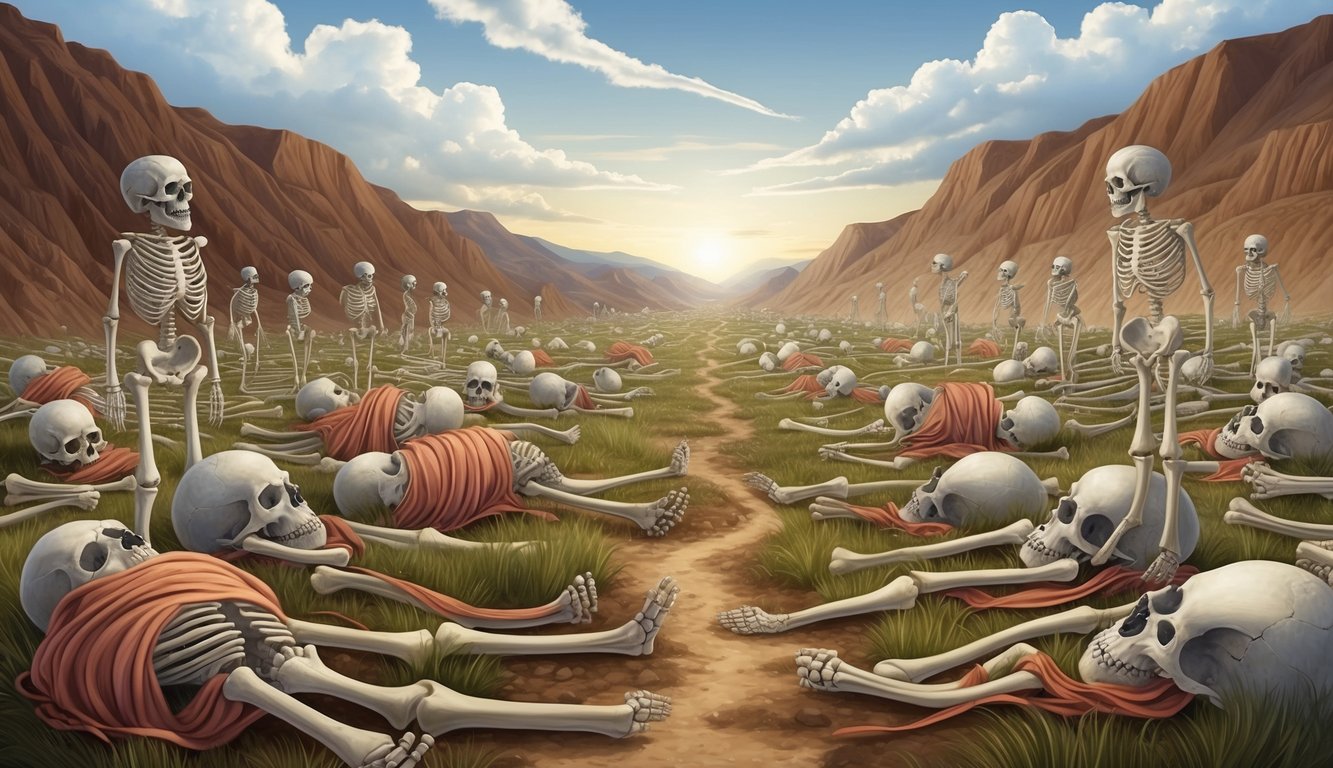Don’t Miss Out On This Unique Astrological Opportunity
Are you tired of spinning your wheels and getting nowhere? Simply put, you’re out of sync: you’re out of alignment with your astral configuration.
But: there’s a kind of map that can help you reclaim your alignment. Think of it as your own personal blueprint to success and happiness: a blueprint that will help you live your most amazing life.
Get started here.
Ezekiel 37 is a fascinating chapter in the Bible that sparks images of a valley filled with dry bones.
This vision was given to Ezekiel, a prophet, as a powerful message of hope and renewal for the people of Israel.
In this vision, God shows that even things that seem lifeless, like dry bones, can be brought back to life with His power.
This symbolizes Israel’s restoration.
The prophecy doesn’t stop at the reanimation of bones.
Ezekiel 37 also includes the unification of Israel and Judah.
These divided nations will become one, under a single ruler, showing God’s plan for unity among His people.
This not only provided hope in Ezekiel’s time but also serves as a reminder of the enduring promise of God’s presence.
This chapter holds rich symbolism and layers of meaning that can intrigue and inspire your faith journey.
As you explore Ezekiel 37, you’ll uncover the profound themes of restoration and divine power.
This story can resonate with anyone seeking assurance of revival and unity through faith.
This vision of dry bones coming to life serves as a powerful reminder that no situation is beyond God’s ability to restore.
By reflecting on Ezekiel 37 alongside 1 John 2 insights, you can deepen your understanding of God’s promises and the transformative power of His word.
This chapter encourages believers to trust in divine renewal, even in the most desolate circumstances.
Key Takeaways
- Dry bones symbolize Israel’s restoration.
- God promises unity under one king.
- Ezekiel 37 inspires hope and renewal.
The Vision of the Valley of Dry Bones
In Ezekiel 37, the prophet Ezekiel is taken to a valley full of dry bones.
This vision shows the power of God’s word to bring new life, restoration, and hope to the people of Israel.
Prophesy to the Dry Bones
You find yourself with Ezekiel in a valley scattered with dry bones, lifeless and disconnected.
God challenges Ezekiel, asking if these bones can live.
Then, God instructs Ezekiel to prophesy to them, telling the bones to hear God’s word.
As Ezekiel speaks, a remarkable transformation takes place.
The bones begin to rattle, and tendons and flesh reattach themselves.
Skin covers them, yet there’s no life in them just yet.
This incredible change symbolizes a promise that God’s power can bring life to that which seems hopeless, just as the people of Israel can be restored.
Breath and Resurrection
In this next part of the vision, God tells Ezekiel to prophesy to the breath.
When Ezekiel obeys, breath enters the bodies, signifying the Spirit of the Lord bringing true life.
The once-dry bones stand as a vast army, filled with life and purpose.
This action represents more than just physical revival; it’s about spiritual awakening and renewal.
God speaks of opening graves and bringing the people back to the land of Israel.
Through this vision, your understanding of the Sovereign Lord’s power, the promise of restored hope, and the renewal of spirit becomes clear.
This message reminds you of the potential for new beginnings, no matter the circumstances.
The Reunification of Israel
Ezekiel 37 speaks about the powerful prophecy of Israel’s reunification.
God’s message reveals the plan to bring together a divided nation under one king, cemented by the covenant of peace.
The Two Sticks Become One
In a symbolic act, Ezekiel was commanded by God to take two sticks and join them as one.
One stick was for Judah and the other for Joseph, representing the northern tribes.
When these sticks were united, it symbolized the reunification of all the tribes of Israel.
This act showed that God planned to heal the long-standing division between these groups.
By coming together as a single stick of wood, it emphasized the restoration of unity and the importance of being one nation.
The hand of the Lord was upon this act, blessing it as a divine mission for the people of Israel.
Restoration as One Nation
Alongside this unification, God promised a true restoration for Israel.
No longer would they be two nations; they would be united under one king.
God vowed that his servant David, or a descendant of David, would rule as one shepherd over this single, reunited nation.
The people of Israel would come from all the mountains of Israel to be part of this unified kingdom.
This promise included a lasting covenant of peace, ensuring they would be God’s people, free from past idols and transgressions.
Through these actions, God affirmed that Israel would be restored as one nation, protected and guided by divine wisdom and grace.
The Promise of God’s Presence

Ezekiel 37 highlights significant promises from God, focusing on His presence with His people.
These promises include an everlasting covenant and establishing His sanctuary among them.
Everlasting Covenant of Peace
In Ezekiel 37, God speaks of an everlasting covenant of peace.
This covenant is a promise from the Lord God to bring stability and harmony to the people of Israel.
It signifies an unbreakable bond between God and His people.
The New International Version (NIV) and the King James Version (KJV) both underscore its permanence.
The word of the Lord assures this peace as a lasting reality.
This promise extends to all nations, reflecting God’s commitment to Israel’s future.
The covenant involves following God’s decrees and laws, creating a just and holy environment.
With God’s pledge, you see His desire for a dwelling place among a great unified army under His servant, David.
God’s Sanctuary Among Them
God’s promise also includes having His sanctuary among the people.
In Ezekiel 37, the presence of a tabernacle signifies a sacred, communal space for worship and connection.
God pledges to live among the Israelites, transforming them into a holy nation.
This divine dwelling place reinforces the Lord God’s commitment to His people.
By promising His presence, He fosters a community rooted in faith and righteousness.
His sanctuary is not just a physical structure, but a spiritual reality where Israel can experience His peace and guidance.
God’s promise of presence shapes a bright future for Israel.
It symbolizes hope, as His sanctuary represents a tangible connection to the divine.
This unifies the people, drawing them closer to Him in their journey through life.
Frequently Asked Questions

Ezekiel 37 presents a powerful vision with themes of resurrection and hope.
The vision of the dry bones is rich in symbolism and continues to inspire interpretations in various religious teachings today.
Understanding this chapter can reveal insights into spiritual renewal and divine promise.
What is the significance of the vision of the dry bones in Ezekiel 37?
The vision of the dry bones is a story of restoration and hope.
It illustrates God’s promise to revive the nation of Israel.
Through Ezekiel, God shows that even when things seem dead and hopeless, renewal and life are possible with faith.
How do different Bible translations like KJV, NKJV, and ESV interpret Ezekiel 37?
Different Bible translations offer varied language and stylistic choices, but the core message remains the same.
The King James Version (KJV), New King James Version (NKJV), and English Standard Version (ESV) all capture the essence of God’s power to bring life to the lifeless nation of Israel.
Could you elaborate on the symbolism behind the resurrection of the dry bones?
The resurrection of dry bones symbolizes the revival of hope and new beginnings.
It represents the power of divine intervention in hopeless situations.
For Israel, it was a promise of restoration to their land, highlighting that nothing is beyond God’s power to renew and restore.
What practical lessons can we learn from the narrative of Ezekiel 37?
Ezekiel 37 teaches the importance of faith and trust in divine plans during hard times.
It reminds you that transformation is possible, even when circumstances appear dire.
The story encourages resilience and hope, underscoring the belief that renewal can come when least expected.
In what context is the valley of dry bones explained within Ezekiel 37?
In Ezekiel 37, the valley of dry bones is shown as a vision given to Ezekiel.
God demonstrates his power to revive a devastated Israel.
It occurs after a series of prophecies, symbolizing the hope of renewal for a nation that felt lost and abandoned.
How is the prophecy in Ezekiel 37 applied in contemporary religious teachings?
Many contemporary religious teachings use Ezekiel 37 to inspire hope and faith.
The vision serves as a metaphor for personal and spiritual renewal.
It emphasizes that divine love and power can bring transformation in individual lives and communities.
This encourages believers to remain steadfast in their faith.



